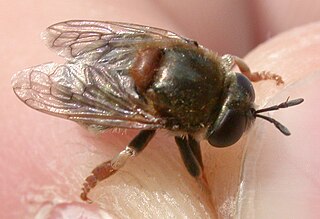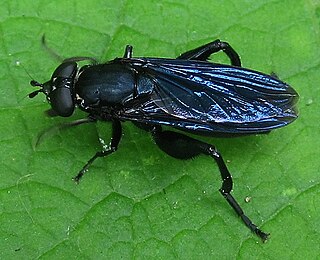
Hoverflies, also called flower flies or syrphids, make up the insect family Syrphidae. As their common name suggests, they are often seen hovering or nectaring at flowers; the adults of many species feed mainly on nectar and pollen, while the larvae (maggots) eat a wide range of foods. In some species, the larvae are saprotrophs, eating decaying plant and animal matter in the soil or in ponds and streams. In other species, the larvae are insectivores, preying on aphids, thrips, and other plant-sucking insects.

The subfamily Microdontinae contains slightly more than 400 species of hoverflies and, while diverse, these species share several characteristics by which they differ from other syrphids. The Microdontinae are myrmecophiles, meaning they live in the nests of ants. Larval Microdontinae are scavengers or predators in ant nests, and, in contrast to other syrphid larvae, have no readily apparent body segmentation. Some species also do not exhibit the typical adult flower-visiting behaviour of other hoverflies, but instead remain near their larval host colonies.

Hover flies of the genus Microdon are unusual among the Diptera. Like other members of the subfamily, they are myrmecophiles, meaning they inhabit the nests of ants.

Xylota segnis, The Brown-toed Forest Fly, is a common species of hoverfly.

Xylota is a Holarctic genus of hoverflies similar in structure to the related genera Chalcosyrphus and Brachypalpoides. As the larvae are saprophytic they're usually found in rotting wood. The adult flies are generally associated with woodland and woodland edges and can often be seen running over the upper sides of leaves. Unlike other syrphids the adults of many species rarely visit flowers preferring instead to gather pollen from leaf surfaces. There are over 100 described species of which 12 can be found in Europe. Seven species have been recorded in Britain. Identification of species has been difficult and identification by photographs is risky.

Dasysyrphus is a genus of hover flies with 50 identified species distributed worldwide. While the genus is relatively easy to identify, the differences between species have a more narrow range of variations. Therefore, identification of species by images of specimens alone should be made with care.

Allograpta is a very large and diverse genus of hoverflies present throughout the world except most of the palearctic region. The adults are brightly coloured flower pollinators and most larvae have a predatory feeding mode involving soft-bodied sternorrhynchans. Certain species have diverged from this and their larvae have been found to be leaf-miners, stem-borers or pollen-feeders.

Criorhina is a genus of hoverflies. Medium to large sized species, black or greenish black, with or without light ground markings mimicking bumblebees. The head is much flattened and broader than the thorax. The antennae are situated upon a prominent conical frontal process, The face is moderately produced below the eyes, downward or forward, in profile. The eyes are bare. The abdomen is elliptical or very short oval. Larvae found in rot holes or decaying hardwoods

Chalcosyrphus is a genus of hoverflies in the subfamily Eristalinae. Many species exhibit some degree of mimicry of various sawflies and other hymenopterans and are often brightly coloured or metallic in hue. The adults are similar in structure and behavior to the related genus Xylota but differ in larval morphology. They can be found throughout Europe, Asia, and North America and seem to prefer damper, boggy habitats. The larvae are saproxylic feeders in rotten wood in these habitats.

Sphegina is a genus of small, slender hoverflies. They are widespread throughout Eurasia and North America. In flight they seem to have long hind legs which they often carry hanging down, making them resemble sphecid or ichneumonid wasps. Adult Sphegina are usually found in damp and shady habitats close to water in forested areas, and several species can often be found together. They often feed on white and yellow flowers of Apiaceae, Ranunculaceae, Asteraceae, and Rosaceae like Crataegus, Sorbus, and Sorbaria. Larvae nest in the sap of living and dead trees or in decaying cambium under tree bark lying in water or other damp conditions. The larvae of some species have been discovered in the tunnels of other xylophagous insects.

Brachyopa is a Holarctic genus of hoverflies whose grey and brown colouration is unusual for this family and these flies can easily be overlooked amongst members of other fly families. The larvae can be found under the bark of dead branches and trees in decaying sap.

Neoascia is a genus of small black and yellow or mostly black flies with a narrow abdomen near the thorax. They occur mainly in damp places among low herbage. The larva of Neosascia are flattened without oral hooks and a have a short posterior spiracular process or "tail" rat-tailed that is saprophagous. In 1925 Curran reviewed the genus Neoascia. In this work a key is provided and ten species are described including four new species some of which have later been determined to be synonyms.
Mixogaster is a genus of hoverflies native to North America and South America, with 21 known species. Mixogaster is distinct by lacking an appendix on vein R4+5, having a reduced and bare metasternum, an unarmed scutellum, and usually an appendix on vein M extending in cell R4+5. Larvae are found in ant nests.
Ubristes is a genus of hoverflies, with four known species. All are characterized by their metatibiae, which are usually enlarged, but always with a brush of long pile along the dorsal edges. These flies are probably mimics of the stingless bees in the tribe Meliponini.

The Brachyopini is a tribe of hoverflies. Unlike many members of this family these flies are generally darker and less colourful though some genera contain species with an attractive metallic lustre e.g. Chrysogaster. Some like Brachyopa are associated with sap runs where their larvae feed on decaying sap. Others are found in boggy areas where their often semiaquatic larvae feed on decaying organic matter.

The Milesiini is a large and diverse tribe of hoverflies. They mimic wasps or hornets.

Milesia is a genus of very large hoverflies, which mimic social wasps. For example, the European species Milesia crabroniformis is a convincing mimic of the hornet species Vespa crabro. Milesia are predominantly Palaeotropical in distribution almost entirely Oriental.

Cynorhinella is a genus of hoverflies from the family Syrphidae, in the order Diptera. Curran erected Cynorhinella for a new species which he named canadensis. He states in the description: "I am unable to place the following specimen in any genus known to me, and it traces out to Cynorhina in Williston's manual, and apparently comes closest to this genus but the thickened, arcuate hind femora with the projection apically, and the more distinct facial side margins separate it. It is related to Chilosia and Chrysochlamys by the last mentioned character, but there is no semblance of bristles and the shape of the abdomen is distinctive."
Frederic Christian Thompson was an American entomologist specializing in the study of Diptera.













